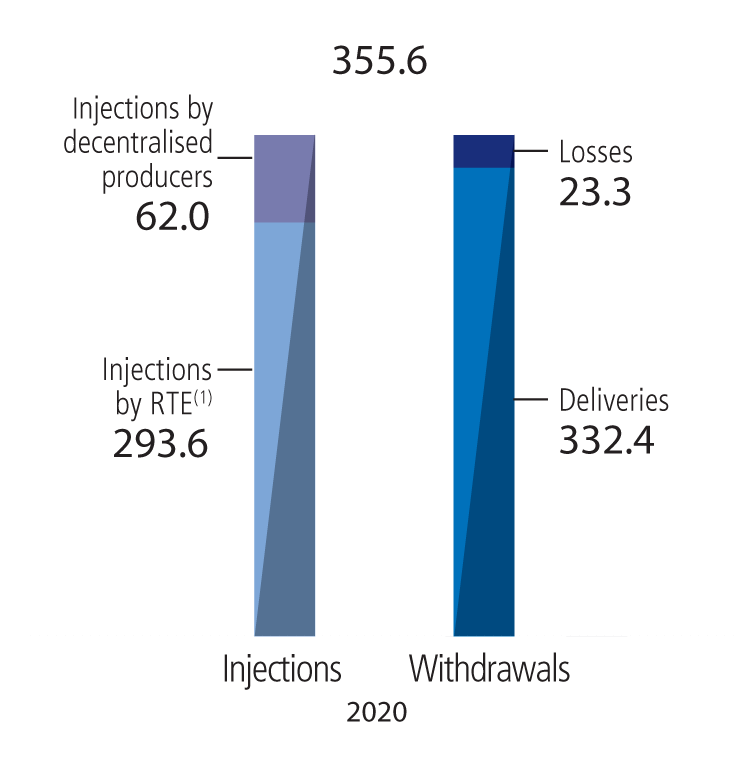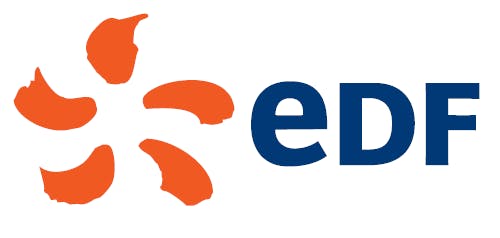RTE and Elia were then gradually joined by grid operators in Western Europe:National Grid ESO (UK), Terna (Italy), 50 Hertz (North-East Germany), REN (Portugal),REE (Spain) and recently Eirgrid and SONI (Ireland).
The implementation of network codes and the new regulations for the French internal electricity market have led to the establishment of regional Coordination Centres, thus making the role of entities such as Coreso in their operational coordination of network managers in Europe official. Consequently, Coreso is currently in the process of being legally designated as the Regional Coordination Centre for the different capacity and operation calculations involving France.
1.4.4.1.32020 Energy report
In 2020, gross consumption stood at 449TWh, i.e. 5% down compared with the previous year. This decrease is due both to the health crisis and to milder temperatures overall.
The French balance of trade amounted to 43.2TWh in 2020, down by 12.5 compared to 2019(1). Commercial export volumes were significantly lower, at 77.8TWh, whereas import volumes are increasing, reaching 34.6TWh. Nevertheless, France exports across all its borders, and is the country with the highest export level inEurope.
The quality of electricity supplied by RTE is estimated on the basis of two indicators: the equivalent outage time and outage frequency. The values of these indicators for 2020 are still provisional. Based on information available to date, the equivalent outage time is 3 min 4 sec (the target set by the CRE is 2 min 48 sec) and 0.341 for outage frequency (the target set by the CRE is 0.46).
1.4.4.2 Distribution – Enedis
37.2 millions
CUSTOMERS
1.38 million
KM NETWORK
€3,962 million
INVESTMENTS IN 2020
38,624
EMPLOYEES
421
CONCESSION AGREEMENTS
As a distribution network operator, Enedis’ main mission is to operate and develop the public electricity distribution network, guaranteeing its security and safety, and over seeing the balance of electricity flows at all times. Founded in 2008, ERDF became Enedis in 2016 and now serves around 95% of the population in mainland France. The other 5% are served by Local Distribution Companies (LDCs). In 2020, Enedis distributed electricity to more than 37.2 million customers (points of delivery) and provided for the injection from more than 458,900 production sites in mainland France, thanks to a network of around 1.38 million kilometres. In addition to this total, 16,700 producers have declared non-grid-feeding self-consumption installations, bringing the total number of production installations up to 475,600.
The distribution network for which Enedis is the concession holder (see section 1.4.4.2.2 “Distribution activities”) is, at 31 December 2020, made up of around:
- 653,390 kilometres of A-type high-voltage (HVA) lines of 20,000 volts;
- 728,391 kilometres of low-voltage (LV) lines of 400 volts;
- 2,224 HVB/HVA source substations;
- 796,148 HVA/LV transformer stations.
Simplified report of energy flows
(in TWh)

2020 : 355.6
Injections : (Injections by RTE (RTE injections volumes are presented net of backfeeding from distribution to transmission grid.) : 293.6, Injections by decentralised producers : 62.0)
Withdrawals : (Deliveries : 332.4, Losses : 23.3)

2019 : 370.9
Injections : (Injections by RTE (RTE injections volumes are presented net of backfeeding from distribution to transmission grid.) : 315.5, Injections by decentralised producers : 55.4)
Withdrawals : (Deliveries : 346.2, Losses : 24.7)
(1) RTE injections volumes are presented net of backfeeding from distribution to transmission grid.
NB: The values correspond to the expression to the first decimal of the precise values.
(1) Source: RTE - Electricity report.
